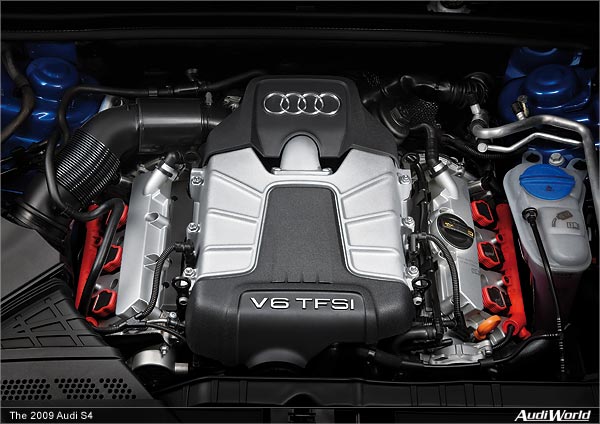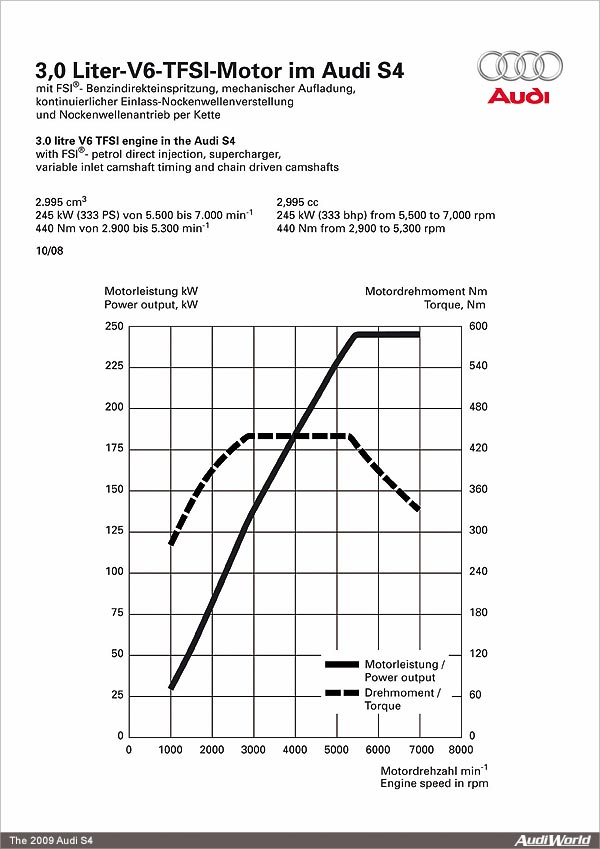The Audi S4: Engine

The 3.0 TFSI is the new range-topping unit in Audis V6 engine family. It develops 245 kW (333 hp) and delivers a powerful 440 Nm of torque (324.53 lb-ft) to the crankshaft between 2,900 and 5,300 rpm. The 3.0 TFSI combines two state-of-the-art technologies gasoline direct injection and mechanical supercharging. These technologies make it a prime example of Audis downsizing philosophy for greater efficiency, i.e. engine capacity is replaced by a supercharger.
The brand with the four rings has a long tradition of supercharged engines. The legendary Grand Prix racing cars built by Auto Union back in the 1930s already featured mechanical superchargers, which coaxed as much as 440 kW (around 600 hp) out of the mighty 16-cylinder and 12-cylinder engines. From the late 1970s on, Audi focused its attention on the exhaust turbocharger, which helped it to a succession of noteworthy triumphs in the world of motor sport. The turbo engines also began to enjoy resounding success in the market.
Now the supercharger is staging a comeback the T in the engine description no longer stands for the turbocharger alone. Extensive comparative tests revealed the mechanical supercharger to be superior to a biturbo concept for the big V6 engine. In conjunction with direct injection this concept has clear advantages in terms of the prioritized features of packaging, starting performance and responsiveness.
The supercharger is so compact that is easily accommodated in the 90-degree V of the cylinder banks, in place of the intake manifold. The engine-driven Poly-V belt that powers the mechanical turbocharger provides full thrust right from idling speed. The 3.0 TFSI delivers its maximum 440 Nm (324.53 lb-ft) at only 2,900 rpm and maintains this constantly until 5,300 rpm. The intermediate sprint from 80 to 120 km/h (49.71 to 74.56 mph) is completed in fourth gear in 4.4 seconds; even in sixth gear it takes a mere 7.1 seconds.
The gas paths after the supercharger are very short which is why the 3.0 TFSI builds up torque extremely quickly when accelerating, even more dynamically than a naturally aspirated engine of the same displacement. The 3.0 TFSI responds directly to the throttle in true sporty fashion, is agile and sprightly, revving up to the maximum of 7,000 rpm with playful ease.
27 percent decrease in consumption
In terms of fuel consumption too, the new S4 and S4 Avant 3.0 TFSI score top marks using only 9.7 liters per 100 km (24.25 US mpg), the sedan outdoes its predecessor by a remarkable 3.6 liters (0.95 US gal), as much as 27 percent. The Audi technology of gasoline direct injection according to the FSI principle was what made this trailblazing efficiency possible in the first place. Unlike conventional solutions, the supercharger is located behind the throttle valve. At loads below supercharging level and when coasting, i.e. when the throttle valve is closed, it lies in a vacuum: due to the low density its rotors are free-running and the amount of power required to drive them is low.
The supercharger is a so-called Roots blower. Inside it, two four-vane rotary pistons counter-rotate at a speed of up to 23,000 rpm, with the air gap between them measuring just a few thousandths of a millimeter. The rotors can deliver 1,000 kilograms (2204.62 lb) of air per hour and force it into the combustion chambers at a boost pressure of up to 0.8 bar. Two intercoolers made of aluminum, connected to a separate coolant circuit, are integrated into the housing in a particularly efficient way. Here, the compressed and thus heated intake air is cooled down again in order to increase the volume of air required for the combustion process.
The three-liter V6 engine itself belongs to Audis family of ultramodern V engines. In addition to the standard cylinder angle of 90 degrees, their attributes include systematic lightweight construction the three-liters crankcase, which is made from cast aluminum/silicon, tips the scales at just 33 kilograms (72.75 lb). The entire engine, including the supercharger, weighs 189 kilograms (416.67 lb). The bore measures 84.5 millimeters (3.33 in) and the stroke 89.0 millimeters (3.5 in), producing a swept volume of 2,995 cc.
Audi has included a whole array of refined high-tech features on the 3.0 TFSI. The crankcase has been adapted to the higher prevailing pressures and all components are frictionally optimized. The intake camshafts can be adjusted through a 42- degree crankshaft angle. In the intake ports, tumble flaps aid mixture preparation.
The injection system is a fundamentally new design. A common rail system with six-hole injectors injects the fuel directly into the combustion chambers at a pressure of up to 150 bar. The injectors highly dynamic response permits up to three fuel injections per operating cycle across an extensive range of the characteristic map. The high compression ratio of 10.3:1 also contributes to optimum combustion and therefore superior efficiency. The direct injection principle is once again the key, because the intensively swirled fuel cools the combustion chamber, reducing the tendency to knock.
The equipment, data, and prices specified refer to the models offered in Germany. Subject to amendment; errors and omissions excepted.
|

